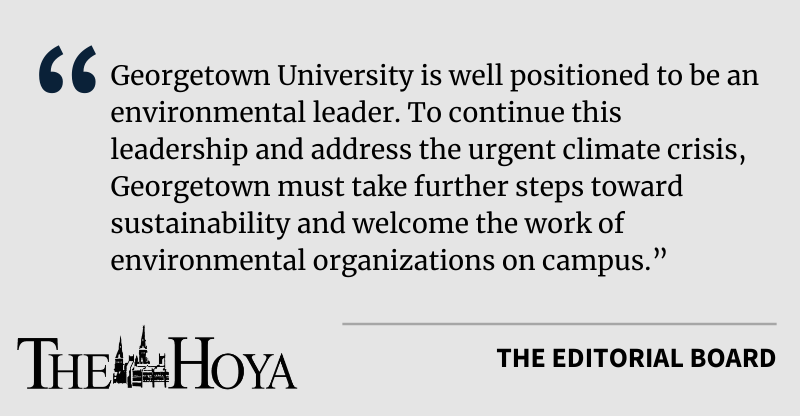With the Biden administration’s announcement of ambitious new emissions reduction targets and climate anxiety on the rise, Georgetown University students and administrators must commit to sustainability with renewed intensity.
The Georgetown community has made the university more sustainable with, for example, student-led composting services and increased use of renewable energy sources. However, the university can and should go further in its efforts to reduce its environmental impact. As the Biden administration introduces plans to cut emissions in half over a 9-year period, now is the time for Georgetown to take concrete steps toward becoming more sustainable. The Editorial Board calls on the university to strengthen its support of sustainability on campus by collaborating with student leaders on a sustainability plan and implementing student demands in the Blue Campus Referendum.
Despite the advocacy of student leaders, the university also has yet to implement a range of policies advocated by student sustainability organizations. According to Rowlie Flores (COL ’22), chair of sustainability for the Georgetown University Student Association Senate, the university has not yet fully implemented the Blue Campus Referendum, which students passed in spring 2020 and calls for emissions reductions and environmental education on campus, in part by reducing transportation emissions.
“While the Blue Campus Referendum has fueled some action, it is far from being fully implemented,” Flores wrote in an email to The Hoya. “We are interested in seeing a full transformation of the Georgetown University Transportation Service to be fully operated with electric buses as well as investments in charging stations to make campus more accessible to electric vehicles.”
A university spokesperson did not provide comment on the Blue Campus Referendum by the time of publication.
Flores also emphasized the importance of new sustainability education opportunities, including “What’s A Hoya?” modules, which offer students housing points in exchange for attendance at educational programs, and urged new infrastructure for Georgetown’s recycling and waste management programs on campus.
Georgetown must enact these initiatives and advance its new sustainability efforts by implementing the demands of the Blue Campus Referendum — including the use of zero emissions vehicles for GUTS and investment in carbon offset programs. These beginning steps will demonstrate credible commitment to sustainability and guide standards of student-university collaboration in the future.
Despite these frustrations, the university has made some substantial progress toward becoming more sustainable, and its success in these efforts should be recognized. Georgetown ranked first in a report released last August comparing renewable electricity usage among U.S. colleges and universities. The university also committed to divest from all fossil fuel companies in its endowment in the next 10 years. Georgetown also offers significant opportunities for environmental education and sustainability research, according to a university spokesperson, such as the core pathway on climate change, a series of interdisciplinary courses addressing complex global challenges from various academic perspectives piloted in 2017 by the Designing the Future(s) Initiative.
Ultimately, the university should work collaboratively with students to move toward improved sustainability. For instance, as student environmental leaders noted last month, Georgetown still does not have a comprehensive sustainability plan, which would outline concrete goals and expectations for addressing sustainability issues. The university should work with leaders of the Georgetown Renewable Energy and Environmental Network to implement the organization’s proposed comprehensive sustainability plan. GREEN’s plan sets out goals for 90% waste divestment by 2035, electrification of the GUTS bus fleet, and for all campus buildings to have net-zero emissions, among other changes. Collaborating with Georgetown community members ensures that future sustainability projects at Georgetown take into account student needs and inspires further student involvement.
Students can contribute to this collaboration process by developing meaningful, realistic expectations for how the student body will promote sustainability on campus and participate in university efforts to reduce Georgetown’s environmental impact. Measures taken by Georgetown to reduce waste and improve recycling, for instance, cannot succeed unless students utilize reusable materials or recycling bins when available. Many of the implemented and planned programs organized by the Office of Sustainability rely heavily on student involvement to succeed, according to Nathan Sonnenfield (MSB ’24), a former student sustainability intern in the Office of Sustainability.
“The Office of Sustainability provides lots of great resources for improving individual sustainability, but they’re not effective unless students and other community members buy into these recommended changes,” Sonnenfield wrote in an email to The Hoya. “When you have 2000 community members all making these minor changes to their day-to-day, then you start to see significant benefits.”
Success in making Georgetown more sustainable will require collaboration, effort and commitment from both administrators and students. Both must be prepared to ensure that sustainability efforts are accessible to all members of the Georgetown community. But student leaders in GREEN, GUSA and other student groups like GU Fossil Free have already done much of the work on the student side with referenda and planning; administrators take the necessary steps to engage student leaders and embrace the demands that they have advocated.
Georgetown is well positioned to be an environmental leader. To continue this leadership and address the urgent climate crisis, Georgetown must take further steps toward sustainability and welcome the work of environmental organizations on campus.
The Hoya’s Editorial Board is composed of six students and is chaired by the Opinion editor. Editorials reflect only the beliefs of a majority of the board and are not representative of The Hoya or any individual member of the board.










Jenny • Apr 29, 2021 at 7:52 pm
I am working on campus and eating at Leo’s. At the very least the university could put aside separate trash cans to allow students to separate out plastic and trash.